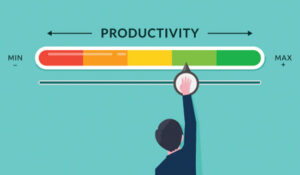Traditional call centre targets can be strong productivity drivers. However, to really improve agent performance, you need to understand the personal motivations of your employees.
Simply pushing your agents harder will not be effective. In fact, it may backfire, leading to agent burnout, exhaustion, and even a decrease in productivity levels.
Prioritizing KPIs and metrics above all else can distract agents from the ultimate purpose of the call centre—helping customers.
By focusing on the humans behind the call centre, you will be able to strengthen relationships and cement customer loyalty. In the end, if you don’t treat your agents with care and compassion, how can you expect them to do the same for the customers?
What Is Call Centre Productivity?
Broadly speaking, call centre productivity is a measure of how effectively your call centre is using its resources to deliver positive customer experiences.
By tracking productivity levels, you can determine whether or not you have hired the right number of employees and if these employees are being managed effectively in pursuit of organizational goals.
As in any other setting, the effective use of time goes a long way to establishing strong productivity levels in a contact centre.
Clever time management is a key differentiator in the call centre industry, setting your organization apart from its competitors.
However, perhaps the most important determining factor when it comes to call centre productivity is agent engagement. In fact, Gallup found that companies with strong levels of employee engagement had 10% higher customer loyalty and 23% higher profitability.
How Do You Measure Call Centre Productivity?
To some extent, the definition of productivity will vary from call centre to call centre, so it’s important that you understand what productivity means to you and develop assessments that are suited to your organization.
By establishing the most relevant metrics for your call centre, you can track productivity levels over time and measure the impact of any changes.
In the following section, we will discuss some traditional call centre metrics like average handling time and first call resolution and how they relate to productivity.
What Are the Traditional Ways to Boost Productivity?
As noted, traditional productivity approaches usually revolve around classic call centre metrics like AHT and first call resolution, which are tangible and easy to measure.
However, putting too much emphasis on quantitative metrics can alienate the agent as it can make them feel like a number rather than a person.
This negativity lingers and can feed into agent–customer interactions, leading to a worse CX. Nonetheless, these traditional methods can be effective and remain an important part of contact centre operations. The key is to find a balance and implement these methods alongside more human-centric processes.
#1. Targets and KPIs
Traditionally, contact centre productivity is measured by tracking KPIs like average handling time, first call resolution, service level, and more. Even metrics that are more typically associated with customer-related outcomes can be useful as a means of identifying productivity issues.
For example, a poor NPS can signal agent inefficiencies, or low CSAT scores can result from a mismanaged team.
Whichever KPIs you are focusing on, the key to improving productivity is to identify which metrics are most relevant to your organization and establish measurable, achievable agent goals linked to these metrics.
#2. Performance Evaluations
Agents are the driving force of any contact centre and the key determinants of overall productivity levels. Using scorecards, you can regularly evaluate agent performance to ensure that every team member is performing to the best of their ability.
Scorecards not only allow you to evaluate performance, but they also enable real-time feedback, tailored training, and collaborative relationships between agents and supervisors.
This provides coaching opportunities for managers and encourages agents to participate in the process and become more invested in their professional development.
#3. Reducing Idle Time
Too much idle time can be a sign of an inefficient contact centre, so it’s important to take steps to minimize it. If agents aren’t making the best use of their time, it slows down operations and makes it difficult to hit performance targets.
However, it’s important to remember that some idle time is inevitable, so trying to reduce it to 0% isn’t a realistic goal.
Furthermore, 0% idle time would actually mean 0% agent availability, leading to issues with customer queue times.
You should also be realistic with your targets, as putting too much pressure on agents can backfire, reducing agent morale and engagement. Instead, try to make the inevitable idle time productive by providing quick bursts of agent training during this downtime.
#4. Managing Average Handling Time
Average handling time (AHT) is a long-established call centre metric and a classic way to measure productivity. AHT is particularly useful, as it measures both agent performance and customer service standards, giving leaders a detailed insight into call centre performance from a single metric.
According to Zendesk’s Customer Experience Trends Report, “66% of customers still typically resolve their issues with a company via telephone”, so it’s clear that AHT remains an important KPI.
However, it’s vital that you don’t prioritize average handling time at the expense of everything else—if agents are rushing through calls just to meet an arbitrary target for AHT, it could harm customer experience and agent morale.
#5. Call Centre Software
According to Salesforce, “81% of service professionals say that the pandemic changed their technology needs.”
In an increasingly digital world, you need to give your agents the right tools to hit their targets. If, for example, you prioritize first call resolution, you need to make sure agents have up-to-date phone technology with little-to-no risk of dropping calls.
More than just providing these tools in the first place, it’s important that agents receive ongoing training on how to get the most out of these tools.
Additionally, call centre software will allow you to track whether or not your agents are meeting their targets and, if not, what areas require improvement.
#6. Reducing Interruptions
One of the best ways to improve productivity is to make the agent’s job easier. By removing as many obstacles as possible, you allow agents to do their best work. In a call centre environment, minimizing interruptions will go a long way to boosting performance and driving KPIs.
Automating mundane tasks allows agents to focus on interacting with customers and providing solutions. The more automated your operational processes are, the less likely an agent will be interrupted by a repetitive task that pulls them away from their job’s core focus.
What Are Other, Human-Centric Ways to Increase Call Centre Productivity?
While the traditional approaches to call centre productivity listed above are still useful, they’re no longer enough.
To really get your call centre operating at full capacity, you need to integrate these classic methods alongside more human-centric approaches.
By focusing on the people behind the contact centre, you can develop beyond the confines of numbers and enable your team to fulfil their potential. Focus on the agent, and it won’t be long before the results emerge in the bottom line.
#1. Invest in Your Agents via Training and Career Development
One of the smartest investments a contact centre leader can make is an investment in their agents. By providing ongoing coaching and supporting career development, you are not only increasing engagement and morale, you are giving agents the tools they need to succeed within your organization, contributing significantly to the overall productivity levels.
With scorecards, you can identify areas for improvement and provide agents with tailored training based on their personal skill gaps.
You can also support their growth by providing access to tools like learning management systems and knowledge bases and even offer off-the-cuff tips to help them provide better service.
#2. Share Company Goals and Make Agents Part of Them
An agent who feels detached from the wider organization may lose sight of why their job matters, leading to burnout and disillusionment.
If you cannot clearly link performance targets to the larger company mission, agents will, understandably, question the purpose of their work.
It’s human nature to push back against rules that seem to exist just for their own sake, so it’s important to emphasize the shared nature of the organization’s goals and regularly explain why the work matters.
This goes beyond big meetings and presentations; you have to embed the company mission in day-to-day tasks and customer interactions and align performance targets with the mission statement.
#3. Improve Engagement by Making Them Feel Valued
A central component of a human-centric approach to productivity is agent engagement. With a human-centric approach, the agent is more than a cog in the machine; they are a valued individual in their own right.
One way to increase engagement is through recognition. Recognizing employees for their achievements is a tried and tested motivational tool across almost every industry.
By rewarding agents for strong performance, you remind them of their personal value, highlight positive trends within your organization, and provide encouragement to the entire team.
Be careful not to patronize your employees, however. A gold star might be a nice reward in elementary school but less so in a professional setting. Keep your awards appropriate and sincere for the best chance of engagement.
#4. Offer Flexibility
The modern workplace is flexible, with adaptable working conditions based on the needs of employees. Things like opportunities for remote work, PTO, and generous maternity & paternity leave can go a long way to boosting morale and, in turn, increasing productivity.
Beyond flexibility in terms of working conditions, the work itself should include a certain level of freedom. If you trust your agents to exercise their own judgment in how they interact with customers and carry out their day-to-day tasks, they’ll reward you for it. After all, who understands the agents better than the agents themselves?
#5. Provide Incentives
We all know that working in a call centre can be a thankless job at times. It’s down to you, as a leader, to insert some gratitude into the equation. If an agent is performing well, let them know.
Incentivizing the job will encourage agents to push themselves and hit their targets, feeding into the overall productivity of the call centre.
Make sure that your incentives are in pursuit of your organization’s specific goals, based on attainable targets, and linked to tangible rewards like bonuses, gift cards, and scheduling priority. Finally, be sure to evaluate your incentive plans on a regular basis and make adjustments if needed.
#6. Use Empathy
Empathy is not only an important component of the agent–customer relationship, it’s essential for a successful agent–manager relationship too.
The empathy you show your agents filters into their interactions with customers, which has a major impact on the overall CX and key metrics like CSAT and NPS.
Just as agents need to understand their customers to help them, you need to understand the pressure agents feel as frontline workers and do what you can to alleviate that pressure.
Try to understand each agent’s personality and tailor your managerial approach accordingly—if you’re there to support your agents, especially when things aren’t going swimmingly, it will show in their performance.
Why Employing a Human-Centric Approach to Productivity Can Yield Better Results
While it’s clear that traditional methods of improving productivity still serve a purpose, they are no longer enough on their own.
Implementing traditional methods in conjunction with a human-centric approach will have a greater impact, leading to increased engagement, better performance, and more positive agent–customer interactions. Focus on the people behind the numbers, and the numbers will take care of themselves.
This blog post has been re-published by kind permission of Scorebuddy – View the Original Article
For more information about Scorebuddy - visit the Scorebuddy Website
Call Centre Helper is not responsible for the content of these guest blog posts. The opinions expressed in this article are those of the author, and do not necessarily reflect those of Call Centre Helper.
Author: Scorebuddy
Published On: 11th Nov 2022 - Last modified: 15th Nov 2022
Read more about - Guest Blogs, Scorebuddy






 Scorebuddy is quality assurance solution for scoring customer service calls, emails and web chat. It is a dedicated, stand-alone staff scoring system based in the cloud, requiring no integration.
Scorebuddy is quality assurance solution for scoring customer service calls, emails and web chat. It is a dedicated, stand-alone staff scoring system based in the cloud, requiring no integration. 































